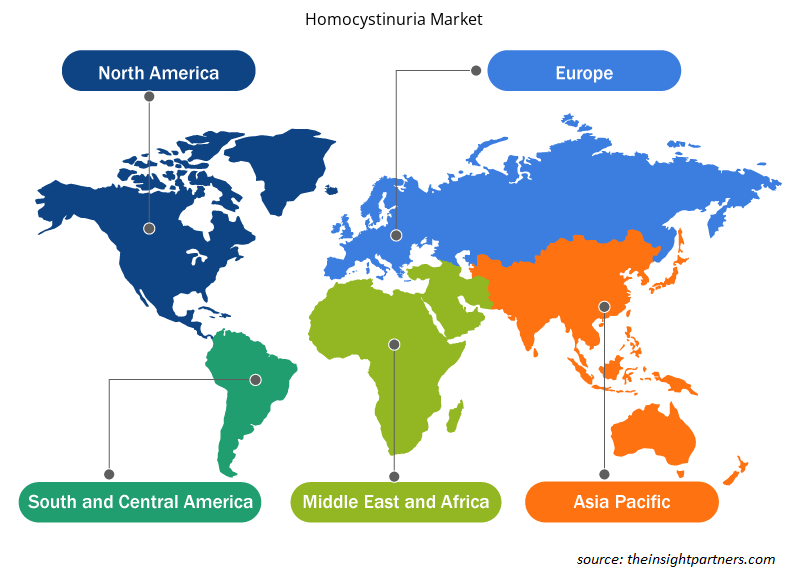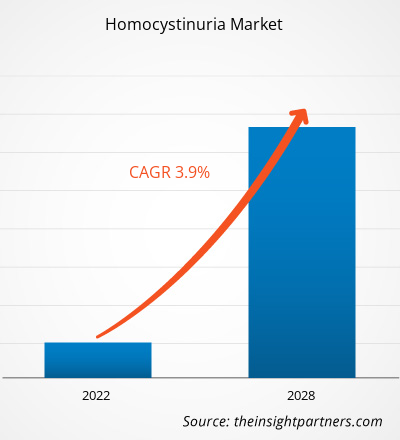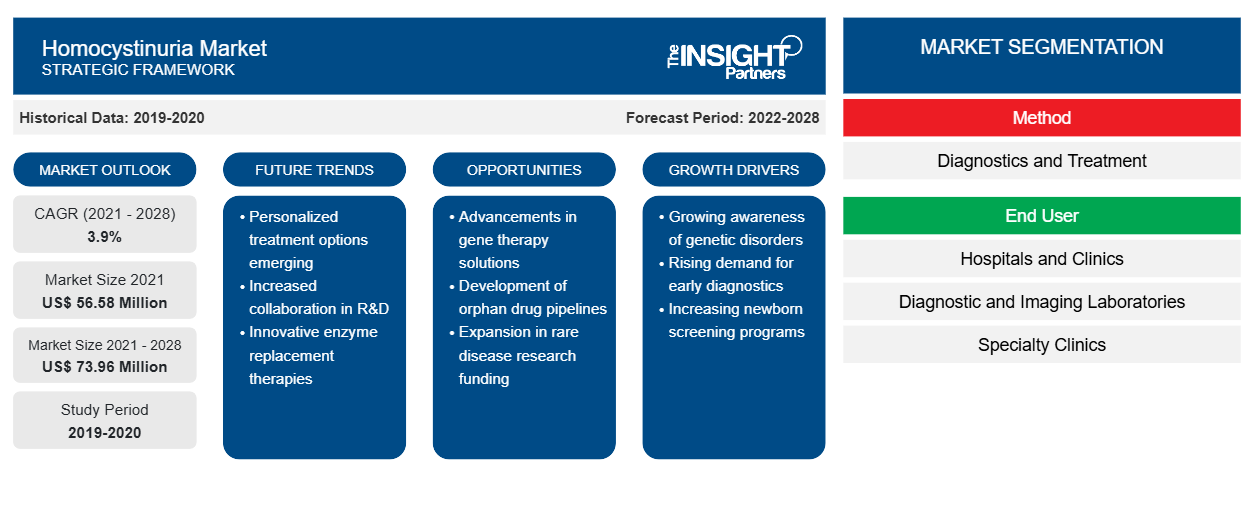Der Homocystinurie-Markt soll von 56,58 Millionen US-Dollar im Jahr 2021 auf 73,96 Millionen US-Dollar im Jahr 2028 anwachsen; für den Zeitraum 2021–2028 wird mit einer durchschnittlichen jährlichen Wachstumsrate von 3,9 % gerechnet.
Homocystinurie ist eine genetische Erkrankung, bei der der Körper nicht in der Lage ist, bestimmte Eiweißbausteine (Aminosäuren) richtig zu verdauen. Homocystinurie tritt in verschiedenen Formen auf, jede mit ihren eigenen Anzeichen und Symptomen sowie einer erblichen Ätiologie. Kurzsichtigkeit (Myopie), Verlagerung der Linse an der Vorderseite des Auges, ein höheres Risiko für unregelmäßige Blutgerinnung und brüchige Knochen, die zu Brüchen (Osteoporose) oder anderen Skelettanomalien neigen, sind die häufigsten Formen der Homocystinurie. Einige der betroffenen Menschen haben auch Entwicklungsverzögerungen und Lernschwierigkeiten.
Passen Sie diesen Bericht Ihren Anforderungen an
Sie erhalten kostenlos individuelle Anpassungen an jedem Bericht, einschließlich Teilen dieses Berichts oder einer Analyse auf Länderebene, eines Excel-Datenpakets sowie tolle Angebote und Rabatte für Start-ups und Universitäten.
-
Holen Sie sich die wichtigsten Markttrends aus diesem Bericht.Dieses KOSTENLOSE Beispiel umfasst eine Datenanalyse von Markttrends bis hin zu Schätzungen und Prognosen.
Das Wachstum des Homocystinurie-Marktes wird auf den zunehmenden Mangel an Vitamin B6 und Vitamin B12 sowie die zunehmende Verbreitung vererbter Stoffwechselstörungen zurückgeführt. Das mangelnde Bewusstsein für verschiedene seltene Erkrankungen und vererbte Stoffwechselstörungen behindert jedoch das Marktwachstum.
Markteinblicke
Zunehmender Mangel an Vitamin B6 und Vitamin B12 treibt den Homocystinurie-Markt an
Die Zunahme von Vitamin-B6- und Vitamin-B12-Mangelmustern führt zu verschiedenen Erkrankungen wie Anämie, megaloblastischer Anämie, mikrozytischer Anämie und einigen Arten von Stoffwechselstörungen, was das Marktwachstum im Prognosezeitraum voraussichtlich ankurbeln wird. Da eine Vitamin-B6-Therapie als wirksame Therapie gegen Homocystinurie gilt, kann ein Mangel an diesem Vitamin den Zustand verschlimmern. Pyridoxin (Vitamin B6) wirkt als Cofaktor der Beta-Synthase und fungiert als Chaperon zur Stabilisierung mehrerer Missense-Mutationen. Einige Patienten mit Homocystinurie sprechen gut auf eine Pyridoxin-Therapie an, die hilft, den Homocysteinspiegel zu senken und so eine Linderung der Erkrankung zu erzielen. Daher gilt Vitamin B6 als unverzichtbar für die Behandlung von Homocystinurie, da nur eine begrenzte Anzahl von Behandlungen zur Heilung der Erkrankung zur Verfügung steht. Der Mangel dieses Enzyms führt zu Anämie und mikrozytischer Anämie. Die steigende Prävalenz von Anämie wird voraussichtlich das Marktwachstum im Prognosezeitraum ankurbeln. Laut der Weltgesundheitsorganisation sind beispielsweise über 1,62 Milliarden Menschen, also 24,8 % der Bevölkerung, von Anämie betroffen. Die Hauptursachen für Anämie sind falsche Ernährung und Mangel an Vitaminen wie B6, B9 und B12. Vor allem Vitamin-B6-Mangel ist eine der Hauptursachen für Anämie. Daher wird erwartet, dass eine Zunahme von Vitamin-B6-Mangelfällen und eine hohe Prävalenz von mit diesem Mangel verbundenen Erkrankungen das Marktwachstum im Prognosezeitraum unterstützen werden.
Methodenbasierte Erkenntnisse
Der globale Homocystinurie-Markt ist je nach Methode in Behandlung und Diagnostik unterteilt. Das Behandlungssegment hielt 2021 einen größeren Marktanteil. Darüber hinaus wird erwartet, dass dasselbe Segment im Prognosezeitraum aufgrund der etablierten Verwendung der Behandlung und der zunehmenden Forschung und Entwicklung neuer Behandlungen für Homocystinurie eine höhere CAGR auf dem Markt verzeichnet.
Regionale Einblicke in den Homocystinurie-Markt
Die regionalen Trends und Faktoren, die den Homocystinurie-Markt im Prognosezeitraum beeinflussen, wurden von den Analysten von Insight Partners ausführlich erläutert. In diesem Abschnitt werden auch die Homocystinurie-Marktsegmente und die Geografie in Nordamerika, Europa, im asiatisch-pazifischen Raum, im Nahen Osten und Afrika sowie in Süd- und Mittelamerika erörtert.

- Holen Sie sich die regionalspezifischen Daten für den Homocystinurie-Markt
Umfang des Homocystinurie-Marktberichts
| Berichtsattribut | Details |
|---|---|
| Marktgröße im Jahr 2021 | 56,58 Millionen US-Dollar |
| Marktgröße bis 2028 | 73,96 Millionen US-Dollar |
| Globale CAGR (2021 - 2028) | 3,9 % |
| Historische Daten | 2019-2020 |
| Prognosezeitraum | 2022–2028 |
| Abgedeckte Segmente |
Nach Methode
|
| Abgedeckte Regionen und Länder |
Nordamerika
|
| Marktführer und wichtige Unternehmensprofile |
|
Dichte der Marktteilnehmer im Bereich Homocystinurie: Auswirkungen auf die Geschäftsdynamik verstehen
Der Homocystinurie-Markt wächst rasant, angetrieben durch die steigende Endverbrauchernachfrage aufgrund von Faktoren wie sich entwickelnden Verbraucherpräferenzen, technologischen Fortschritten und einem größeren Bewusstsein für die Vorteile des Produkts. Mit steigender Nachfrage erweitern Unternehmen ihr Angebot, entwickeln Innovationen, um die Bedürfnisse der Verbraucher zu erfüllen, und nutzen neue Trends, was das Marktwachstum weiter ankurbelt.
Die Marktteilnehmerdichte bezieht sich auf die Verteilung der Firmen oder Unternehmen, die in einem bestimmten Markt oder einer bestimmten Branche tätig sind. Sie gibt an, wie viele Wettbewerber (Marktteilnehmer) in einem bestimmten Marktraum im Verhältnis zu seiner Größe oder seinem gesamten Marktwert präsent sind.
Die wichtigsten auf dem Homocystinurie-Markt tätigen Unternehmen sind:
- BASF SE
- HUAZHONG PHARMACEUTICAL
- Pfizer Inc.
- MYLAN NV
- Aeglea BioTherapeutics
Haftungsausschluss : Die oben aufgeführten Unternehmen sind nicht in einer bestimmten Reihenfolge aufgeführt.

- Erhalten Sie einen Überblick über die wichtigsten Akteure auf dem Homocystinurie-Markt
Endbenutzerbasierte Erkenntnisse
Der globale Homocystinurie-Markt ist nach Endverbrauchern segmentiert in Diagnostik- und Bildgebungslabore, Krankenhäuser und Kliniken, Fachkliniken sowie akademische und Forschungsinstitute. Im Jahr 2021 hielt das Segment der Diagnostik- und Bildgebungslabore den größten Marktanteil. Darüber hinaus wird erwartet, dass das Segment im Zeitraum 2021–2028 aufgrund der steigenden Zahl von Diagnosen vererbter Stoffwechselstörungen in Diagnostik- und Bildgebungslaboren die höchste durchschnittliche jährliche Wachstumsrate von 4,2 % verzeichnen wird.
Produkteinführungen und Zulassungen sind häufig von Unternehmen angewandte Strategien, um ihre globale Präsenz und ihr Produktportfolio zu erweitern. Darüber hinaus konzentrieren sich die Akteure auf dem Homocystinurie-Markt auf die Partnerschaftsstrategie, um ihren Kundenstamm zu vergrößern, was ihnen wiederum ermöglicht, ihren Markennamen weltweit aufrechtzuerhalten.
Der Bericht segmentiert den Homocystinurie-Markt wie folgt
Homocystinurie-Markt – nach Methode
-
Behandlung
- Pyridoxin
- Betain
- Sonstiges
-
Diagnose
- Genetische Tests
- Aminosäure-Screening-Test
- Leberenzymtest
- Sonstiges
Homocystinurie-Markt – nach Endverbraucher
- Krankenhäuser und Kliniken
- Diagnostik- und Bildgebungslabore
- Spezialkliniken
- Akademische und Forschungsinstitute
Homocystinurie-Markt – nach Geografie
-
Nordamerika
- UNS
- Kanada
- Mexiko
-
Europa
- Vereinigtes Königreich
- Deutschland
- Frankreich
- Italien
- Spanien
- Restliches Europa
-
Asien-Pazifik
- China
- Japan
- Indien
- Australien
- Südkorea
- Restlicher Asien-Pazifik-Raum
-
Naher Osten und Afrika
- Vereinigte Arabische Emirate
- Saudi-Arabien
- Südafrika
- Restlicher Naher Osten und Afrika
-
Süd- und Mittelamerika
- Brasilien
- Argentinien
- Restliches Süd- und Mittelamerika
Firmenprofile
- BASF SE
- HUAZHONG PHARMACEUTICAL
- Pfizer Inc.
- MYLAN NV
- Aeglea BioTherapeutics
- Amino GMBH
- KAO Corporation
- DSM Corporation
- Verwaiste Technologien
- Fresenius Kabi AG
- Historische Analyse (2 Jahre), Basisjahr, Prognose (7 Jahre) mit CAGR
- PEST- und SWOT-Analyse
- Marktgröße Wert/Volumen – Global, Regional, Land
- Branchen- und Wettbewerbslandschaft
- Excel-Datensatz
Aktuelle Berichte
Erfahrungsberichte
Grund zum Kauf
- Fundierte Entscheidungsfindung
- Marktdynamik verstehen
- Wettbewerbsanalyse
- Kundeneinblicke
- Marktprognosen
- Risikominimierung
- Strategische Planung
- Investitionsbegründung
- Identifizierung neuer Märkte
- Verbesserung von Marketingstrategien
- Steigerung der Betriebseffizienz
- Anpassung an regulatorische Trends























 Kostenlose Probe anfordern für - Homocystinurie-Markt
Kostenlose Probe anfordern für - Homocystinurie-Markt